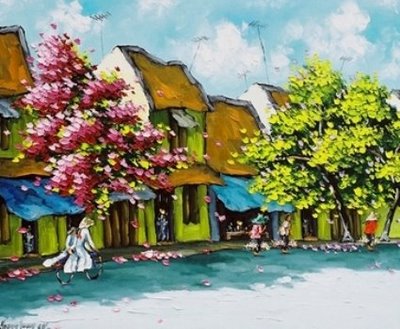Compared to other Asian countries, and according to several art commentators, Vietnam was the earliest to merge into the the main stream of modern art, as defined by the West, in both form and content. Such a fact can be easily seen with the coming into existence of Ecole Des Beaux Arts (Indochina’s School of Fine Art) in the early 1930s, with the presence of professors from France.
Past and Present …
In Northern Vietnam nowadays, the tradition of Dong Ho Paintings, or the “self-portraits” of Vietnam’ s earliest folk painting traditions, are well preserved. In 1024, there existed 2,000 paintings of Buddha which served as the foundation of the presently – popular Dong Ho Paintings. And from Dong Ho Village, where stands the great 18-century tombstone produced in Canh Hung Dynasty, on which details of the painting trade were recorded, 17 different clans specialized in wood-block have supplied the market with paintings and sculptures depicting history, daily activities, landscapes, social courtesies, proverbs, ritual ceremonies, caricatures, etc. to convey popular philosophy.
Over time and at present, the Dong Ho traditions are reflected, in various decrees and in both content and composition, in the works of contemporary artists. It could be said, perhaps, that the very touch of popular traces have distinguished Vietnam’ s contemporary art from that of the world.
Vietnamese art in the world and domestic markets.
Between 1988 – 1990, which may be seen as a landmark, in Vietnam and especially in Ho Chi Minh City an art market came into being. Earlier, in the early 1980s, some overseas Vietnamese from The U.S., Australia, and Canada came back to collect paintings of famous artists of pre-1975 Saigon, e.g. Ngoc Dung, Thai Tuan, Vi Y, Duy Thanh, etc. and of such renowned artists as Nguyen Gia Tri, Bui Xuan Phai, etc.. Their activity gradually became a catalyst for the emergence of an exciting art market from 1990 on.
Since late 1,991 and carry 1992, any- how, in Hanoi, Hue, Da Nang, and especially Ho Chi Minh City, galleries have sprung up one after another and exhibitions have taken place every week, expressing a novel vitality to Vietnam’s contemporary art both at home and abroad.

